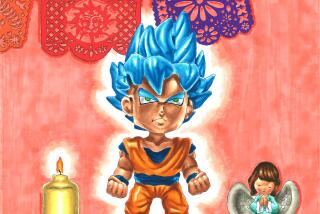Top draw? It’s Yugi
- Share via
It’s a blisteringly hot Sunday afternoon outside Game Guys in Van Nuys, but dozens of kids ages 8 to 21 have gathered in the store parking lot to compete in the weekly Yu-Gi-Oh! tournament. The scene is repeated every Sunday, whether it’s hot or cold, windy or rainy, regardless of what’s on TV or whether there are tests on Monday.
Almost all of the players are boys, but they include Asians, Latinos, African Americans and Caucasians. The kids pay no attention to age or ethnicity as they discuss new cards and joke about previous matches: Game Guys is their clubhouse, and anyone interested in Yu-Gi-Oh! is welcome. Sixteen-year-old Greg Nishimato, who’s been playing for about a year and half, says, “The game is fun as a hobby, and as a way of meeting new people and making new friends.”
Parents might envy the obedience Game Guys manager Scott Sohn receives when he tells players to line up, present their cards for inspection, draw partners, etc. The talking and laughing diminish as the kids pair off and sit down at tables to “duel.” The rules of Yu-Gi-Oh! require duelists to behave in a “polite, friendly and respectful manner” toward one another.
“The popularity of Yu-Gi-Oh! is linked to kids’ desire to play at competition. Like chess, it’s not that difficult to learn, but the number of cards and possibilities make it difficult to master,” says Al Kahn, president and chief executive of 4Kids Entertainment, the distributor of Yu-Gi-Oh! on video. “I think kids enjoy trying to be the best, but the idea of being able to control all the wonderful monsters is also appealing.”
The mainstream media have paid little attention to Yu-Gi-Oh! and Beyblade, another game tied to a hit anime series, but both properties are hugely successful. For TV networks wondering where young viewers went, in fact for anyone trying to sort through the prized but elusive minds of adolescent and preadolescent boys, Yugi could just be the answer.
In 2003, Yu-Gi-Oh! trading cards, videos and other merchandise were expected to account for for more than $2 billion in U.S. sales, on top of money generated by the Kids’ WB TV series. More than 1,000 Yu-Gi-Oh! products have been licensed, not counting the cards used in the game. Visitors to any Southern California mall will see spiky-haired, blond Yugi and his pals on T-shirts, aloha shirts and skateboards.
General Mills makes Yu-Gi-Oh! cereal (honey-sweetened corn triangles). An estimated 500,000 kids and adults in North America participate in weekly Yu-Gi-Oh! tournaments like ones at Game Guys. Some 10,000 people attended the Yu-Gi-Oh! World Championship in New York last summer.
Hasbro has sold more than 15 million Beyblade tops in the U.S. Atari released Beyblade: Ultimate Blader Jam for Gameboy in November, about the time the Beyblade trading card game hit the stores. On Nov. 15, 250 competitors and 1,000 spectators turned out for the first Beyblade Battle Assn. Blader Jam Championships in Anaheim. Twice that number showed up at the East Coast championships a week later in New York, with the winners slated to meet in March at the North American finals.
Beyblade is basically a variation on battling tops: Kids use special plastic “blades” (tops) and stage their battles in small plastic “stadiums.” The anime series, which airs on ABC, premiered in Japan in 2001. It was based on the manga (graphic novel) “Bakuten Shoot -- Explosive Spinning Top” by Takao Aoki, which follows 13-year-old Tyson (Takao in Japanese) and his teammates as they rise to the world Beyblade championships using the magical “Bit Beasts” that inhabit their tops.
The vastly more complicated Yu-Gi-Oh! also began as a manga by Kazuki Takahashi in 1996, and debuted in animation four years later. Players build personal decks of at least 40 cards, choosing from about 1,200 possibilities. The cards depict monsters with various powers that duelists use to defeat opponents. In the anime, which airs on Kids’ WB, Yami Yugi is forced to become a champion duelist to rescue his grandfather from the sinister Maximillion Pegasus.
“ ‘Beyblade’ had a really appealing core play pattern and a sport element, which we thought would give us an opportunity to position it as kind of an extreme sport for 8- to 12-year-olds,” said Doug Murphy, executive vice president for business development at Nelvana Ltd., which is producing the animated series. “As we were crafting ‘Beyblade’ for North American and Western markets, we rewrote all the scripts and brought in new music to give the show a bit of an edge. We added the two sports announcer characters who didn’t exist in the Japanese series to emphasize that feel.”
“We focus-group test everything before we put it on the air, and ‘Yu-Gi-Oh!’ was the highest-testing series we’ve ever put through, so I wasn’t surprised that it became our No. 1 series,” said John Hardman, senior vice president for programming at Kids’ WB. “When I first came here, we talked about how Pokemon was a language children spoke that adults couldn’t understand, which was part of its appeal. There’s something similar about Yu-Gi-Oh!: Adults don’t understand the card play and dueling. I can play Pokemon, but in Yu-Gi-Oh!, I’m usually beaten by about my third move.”
The runaway financial success of Beyblade and Yu-Gi-Oh! is due in part to careful marketing. Murphy explains, “Beyblade has a collectibility aspect that keeps it fresh. Hasbro releases new tops every month, which keeps the retailers happy: It drives customers and their moms to come back to the store to see what’s new. With Beyblade, we maintain a kind of managed scarcity. We don’t want to over-ship the market; we want to keep it a little bit short so there’s a sense of urgency. I think that plan has helped to maintain interest in the property.”
“In the past, adults paid attention to a series because action figures and toys were sold -- all the kids had Ninja Turtles,” adds Hardman. “Yu-Gi-Oh! isn’t an action-figure series, it’s a card-playing series. You’re not going to see a kid playing with a toy: He’s going to be reading a comic book by himself or dueling with a friend. There’s certainly as much merchandise, but it’s in different categories that people aren’t used to paying attention to.”
Yu-Gi-Oh! and Beyblade may continue to grow in popularity, or 2003 may mark their apex. Both shows are earning good ratings, and Warner Bros. will release the “Yu-Gi-Oh!” theatrical film here this year (the “Beyblade” feature has yet to be released in America). Even after they peak, anime shows and related games have long shelf lives. There have been more than a dozen “Gundam” series and features since the franchise debuted in 1979; “Robotech” (1985) and “Transformers” (1985) still have their fans. And although some of their friends dismiss it as “so 1999,” many kids are playing and watching “Pokemon.”


